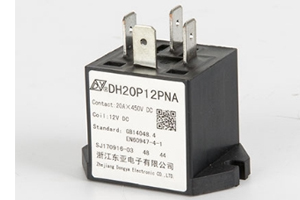In the domain of modern electrical engineering, the electromagnetic compatibility (EMC) of high voltage DC contactors has emerged as a critical factor. As these contactors are deployed in a diverse range of applications, from electric vehicles to industrial automation systems, ensuring their seamless operation within electromagnetic environments is of paramount importance.
High voltage DC contactors are designed with specific measures to enhance their EMC. The materials used in their construction play a significant role. High-quality conductive and magnetic materials are carefully selected to minimize electromagnetic interference (EMI) emissions. For instance, the enclosures are often made of materials with good shielding properties to prevent the leakage of electromagnetic fields. This helps in containing the electromagnetic energy within the contactor and reducing its impact on the surrounding electrical components.
During the operation of high voltage DC contactors, various electrical and magnetic processes occur. The switching of high currents and voltages can generate transient electromagnetic pulses. To mitigate the effects of these pulses on other sensitive equipment, internal filtering circuits are incorporated. These circuits are designed to absorb or divert the high-frequency components of the electromagnetic emissions, thereby reducing the risk of EMI.
In applications such as electric vehicle charging stations, where multiple electrical devices are in close proximity, the EMC of high voltage DC contactors is put to the test. A well-designed contactor with good EMC characteristics will not cause interference to the vehicle's onboard electronics or the charging infrastructure's control systems. This ensures the reliable operation of the entire charging process and the safety of the vehicle and its users.
In industrial settings, where complex electrical systems are at work, high voltage DC contactors need to coexist with other machinery and control systems. Their EMC capabilities determine whether they can function without causing disruptions. For example, in a factory automation line, if a contactor emits excessive EMI, it could lead to malfunctions in sensors, actuators, or programmable logic controllers (PLCs), resulting in production downtime and increased maintenance costs.
To evaluate the EMC of high voltage DC contactors, standardized testing procedures are employed. These tests measure parameters such as conducted emissions, radiated emissions, and immunity to electromagnetic disturbances. Manufacturers strive to meet or exceed the relevant industry standards to ensure the quality and reliability of their products.
In conclusion, the electromagnetic compatibility of high voltage DC contactors is a crucial aspect that influences their performance and the functionality of the systems they are integrated into. Through careful design, material selection, and the incorporation of filtering circuits, contactors can achieve satisfactory EMC levels. Continuous research and development in this area are essential to keep pace with the evolving technological landscape and the increasing demands for electromagnetic compatibility in modern electrical applications.

 English
English  한국어
한국어




